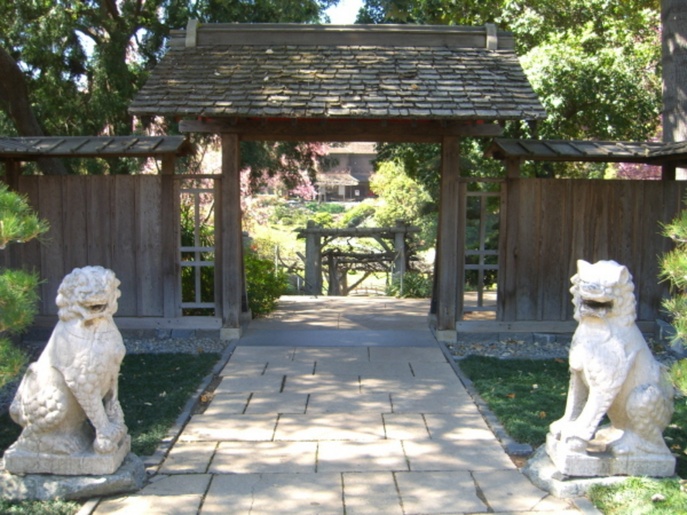
|
||
 Enlarge
Enlarge
|
Licensing | |
The Japanese Garden located within Huntington Gardens attempts to provide an Asian style landscape that is both beautiful and cultural. Built from the collection of Japanese art importer and collector, George Marsh, the garden consists of plants, ornaments and a Japanese house. Established in 1912, the aim of the garden was to show the beauty of nature in an Asian style. With the addition of a moon bridge, gong tower, and Zen as well as Bonsai court, the garden was finally completed in 1968.
Upon entering the garden, the visitor begins to be bombarded with various aspects that the designers believed to be representational of Japanese culture. Cherry trees with budding blossoms greet the viewer as they enter. A Japanese bridge and a koi pond complete the scene as various Asian plants decorate the garden, overwhelming the visitor with the beauty of the region. The place attempts to create a link between the viewer and the culture that the garden is representing, specifically Japan.
While the Japanese Garden may appear at to be representative of Japan at first glance, a closer examination reveals some key contradictions woven into the exhibit. Rather than remaining faithful to the nation’s origins, the Japanese garden consists of a variety of plants and images that are prevalent throughout Asia and not just exclusive to the island nation. In regards to the flora, these appropriated plants are split into two categories: hybrid and foreign. Plants such as the Japanese Maple are considered a hybrid as they can be found not only in Japan but also in Korea and China. Vegetation such as the Chinese Snowball is considered foreign, as it is not naturally found within Japan, which in this case is native to China. These misappropriated plants note a subconscious blending of Asian cultures, attempting to make a universal homogeny in the region to create an imaginary Asia.
The garden continues to press the concept of a homogenous Asian identity through a continual misappropriation of statues. Buddhist statues can be found scattered throughout the garden without labels or information about the pieces. By failing to provide data regarding the link between these statues and Japan, the garden continues to demonstrate a relativity of Asian cultures. Rather than representing specific aspects of Japanese culture, the statues become examples of the representation of the exoticism of Japan and a shared culture of all of Asia. These statues may have been included by the designer because of their appearance is distinctly Asian, and thus fit with the preconceived idea of an imagined Japan. Scholar James Clifford argues that, “We need to be suspicious of an almost-automatic tendency to relegate non-Western people and objects to the pasts of an increasingly homogenous humanity.” (162) By being mindful of this tendency, the notion to lump all of Asia’s cultures together into one universal whole can be more easily avoided.
Other concerns arise in regards to appropriation and exoticism arises with the Japanese House and the Zen court. Originally built as a tea house by the Japanese government, the building was eventually transported to Huntington Gardens after being transformed into a restaurant in Pasadena. When the structure built as a tea house becomes a representation of a traditional Japanese House within the gardens, it creates questions regarding misappropriation as it fails to coincide with the buildings original intent.
The Zen court produces a similar problem as it attempts to fuse a religious aspect of Japanese culture into an aesthetic display. Containing a rock garden, which consists of stones and pebbles that symbolize a model landscape, the unique site is found within Zen temples as a place of contemplation. Representing mountains and waters, these large rocks and pebbles add to the exoticism that the garden produces. The placement of a rock garden, which holds religious connotations, in a commercial exhibit, undermines its original intent as it is changed to fit the new location.
A Japanese garden established anywhere outside of the actual nation raises questions regarding authenticity and integrity. The exhibit in Huntington Garden contains several elements that are modeled after a Japanese-style stroll garden. However, it fails to place these plants, statues and buildings in the right context as the garden does not provide the accurate or necessary information needed to educate the viewer. Several instances of misappropriation in regards to plant and statue origins alter their meanings as they create an exotic and relative Asian homogeny. While the Japanese Garden may contain both beauty and culture, the viewer must always be vigilant to remember the larger purposes and concepts behind its elements as they may create an imaginary world, which can create a lasting representation of the nation in one’s mind.
 dmartinez
—
更新日 3月 30 2011 8:01 p.m.
dmartinez
—
更新日 3月 30 2011 8:01 p.m.
Part of these albums

|
Landscaping America: Occidental College Student Research mpitelka
mpitelka
|

|


 Journal feed
Journal feed
